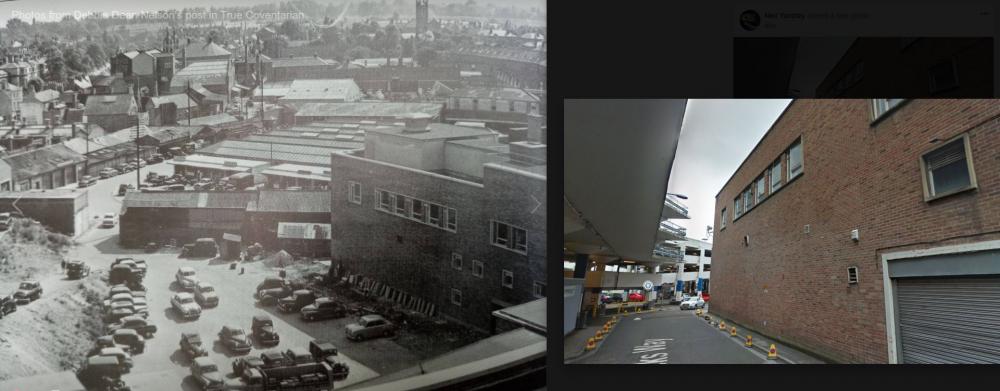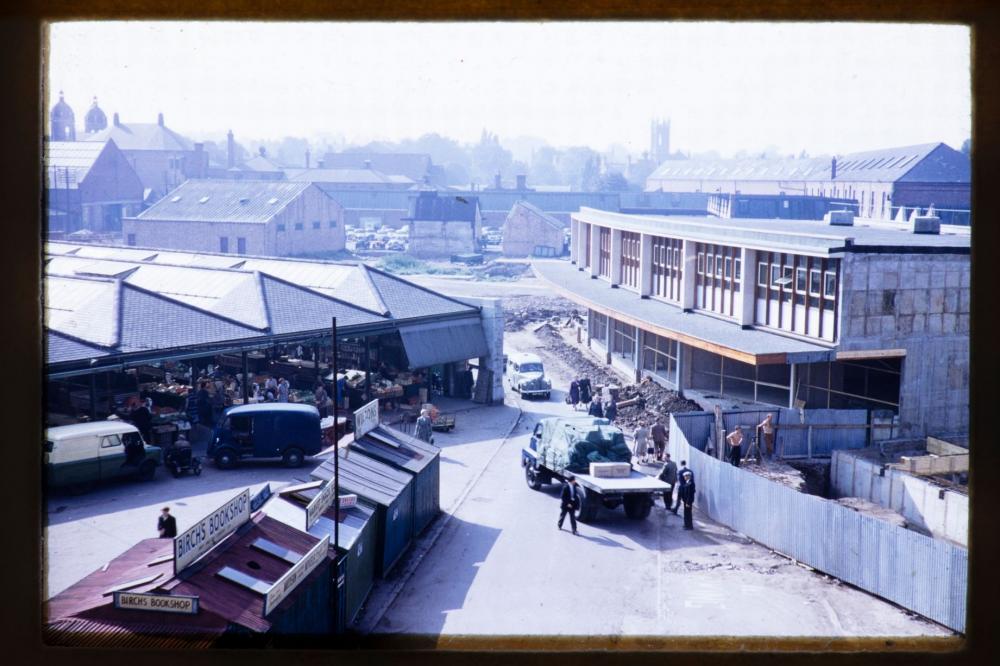NeilsYard
Coventry
Thread starter
|
121 of 158
Tue 21st May 2019 10:28am
On 13th Apr 2012 7:47pm, Rob Orland said:
Well, just finished a bit of a mammoth scanning session! Firstly, though, I'd like to thank LdeMain for her kindness in passing that 1966 Review Plan on to me.
And now for your viewing pleasure and entertainment.... the first 19 pages of the plan - the overview, with photos, models and diagrams. I'll try to put more on as I find some time, but this first section sets the tone of the plan, and in many ways echoes the earlier 1945 plan which laid out the first post-war proposals.
For convenience, I've placed these images in The Gallery.
I hope they will provoke a few memories....
I've just been given a copy of that Rob. Blimey, someone really went to town (so to speak) on that didn't they?! A lot of historic negativity written in to it to create a 'we need a modern Coventry' impression. |
|
Town Planning and Development -
Post-war redevelopment
|
NeilsYard
Coventry
Thread starter
|
122 of 158
Mon 3rd Aug 2020 11:07am
Thanks to my friend Dean Nelson on the True Cov FB page. He posted this one today, an unusual (late 50's?) view looking south across the Barracks Market. What really interested me was the capture of the then 'new' elements of Market Way, still visible today.

|
|
Town Planning and Development -
Post-war redevelopment
|
Helen F
Warrington
|
123 of 158
Mon 3rd Aug 2020 6:22pm
I often wonder about the changes eg the bricked up windows. |
|
Town Planning and Development -
Post-war redevelopment
|
PeterB
Mount Nod
|
124 of 158
Wed 27th Jan 2021 11:01am
|
|
Town Planning and Development -
Post-war redevelopment
|
NeilsYard
Coventry
Thread starter
|
125 of 158
Thu 28th Jan 2021 12:36pm
Following the #133 image, this one of the developing Market Way postwar is from the newly released Uni Collection. It shows old versus new nicely with the old Barracks Market 'carrying on regardless'. I think the Market Tavern would go on to be built on the right.
 |
|
Town Planning and Development -
Post-war redevelopment
|
NeilsYard
Coventry
Thread starter
|
126 of 158
Thu 28th Jan 2021 1:58pm
Just looking more at that one - I think that's the remains of Bull Yard in the centre |
|
Town Planning and Development -
Post-war redevelopment
|
Midland Red
|
127 of 158
Thu 28th Jan 2021 2:08pm
Neil. Top left are the twin towers of Warwick Road Congregational Church  |
|
Town Planning and Development -
Post-war redevelopment
|
Rob Orland
Historic Coventry
|
128 of 158
Mon 12th Jul 2021 7:27pm
Good evening all,
A |
|
Town Planning and Development -
Post-war redevelopment
|
Helen F
Warrington
|
129 of 158
Mon 12th Jul 2021 8:39pm
Setting aside the sharpest source of grief - the dead and injured - I sometimes wonder how the experiences of the slum clearances were merged in people's minds with the war. For a long time the pace of change in the city was quite slow then all of a sudden housing was being cleared for factories and old shops were replaced by new arcades. Was the era before the war cheerful because cramped streets and grungey buildings were being transformed or were they as nostalgic as we are? Was losing the new builds and the remaining old stuff doubly traumatic? Did people see stretches of cleared land and assume that they were all Hitler's work when in reality they'd been razed just before the bombing?
Buildings sometimes feel like they should last forever, unlike people. Is there some very deep part of our psyche that is shocked by rapid change? |
|
Town Planning and Development -
Post-war redevelopment
|
belushi
coventry
|
130 of 158
Tue 13th Jul 2021 11:50am
I once was told that more pubs were destroyed in the building of the Ring Road than were destroyed by German bombers. Is this true?
|
|
Town Planning and Development -
Post-war redevelopment
|
Helen F
Warrington
|
131 of 158
Tue 13th Jul 2021 12:28pm
It's certainly possible belushi although I've not examined the issue. The roads were slowly colonised with brick buildings and often the first to be able to afford it were the pubs and hotels. Rebuilding didn't just allow for a more modern interior but it could expand upwards and backwards into the land behind that didn't necessarily have a court of cottages but instead had buildings associated with brewing and guests. The brick buildings more often survived, especially on the outer edges that were to become the ring road. Many of the remaining timber pubs were destroyed before the war. |
|
Town Planning and Development -
Post-war redevelopment
|
Kaga simpson
Peacehaven, East Sussex
|
132 of 158
Wed 14th Jul 2021 8:25am
Reply on Kaga's topic with many details on and around the war.
|
|
Town Planning and Development -
Post-war redevelopment
|
OddSock
Coventry
|
133 of 158
Wed 14th Jul 2021 9:31am
Having read Jessica's introduction, I understand it to mean her intention is to examine how the events of November 1940 have shaped people's attitudes and opinions towards the place they live, and is not necessarily aimed at those who actually lived through those terrible times?
I was born in the sixties and have lived in Coventry for most of my life - how do I reflect on the bombings, the aftermath, and how the city has grown and developed since? Do those events 'strengthen' my bond with the city? Do I feel a sense of pride that 'my' city was able to rebuild? Do I feel a 'kinship' with Coventry that I may well not have had if I had been born, say, in Leamington or Stratford, simply because of the enormity of damage and loss of life?
Personally, having an interest in its history, I find the Coventry story fascinating and inspirational. I feel 'at home' in the city, and a very strong place attachment, which I believe has been enhanced by reading and learning about 'The Blitz' and the years that followed.
I wish Jessica well.
OddSock: Particularly interested in the family surnames Cowley, Shale, & Pratt in Coventry!
|
|
Town Planning and Development -
Post-war redevelopment
|
Helen F
Warrington
|
134 of 158
Wed 14th Jul 2021 10:28am
I take it to mean the same Oddsock. There is plenty of post war reaction to the damage on this site although it's hard to articulate it as a clear picture. Most people have some experience of the aftereffects of the war even if they were born later. Bombed out buildings that remained as piles of bricks in a weed choked area, often the playground of local kids. Who never found military paraphenalia or had an unexploded bomb turn up in their area and be blown up (the bomb, not the people)?
I started out with no idea of the scope of Coventry's medieval jewels and was outraged at the damage the bombing did to the buildings. I did know about the deaths but as that was universal to many places, that sting wasn't Coventry specific for me. Over time my anger at Germany over the destruction has been less sharp with the realisation that pre and post war modernisation destroyed as least much of the city's gems. When I arrived in Coventry in the 90s, the city seemed to hate itself. It was rundown, dirty and unloved. It wallowed somewhat in the war damage. I used to think that it had been that way since the war but I think that post war events had more of an effect on Coventry's lack of self respect. All fairness to recent building and the artwork for the City of Culture, the city now looks like it has learned to love itself and hopefully the feeling will last. |
|
Town Planning and Development -
Post-war redevelopment
|
Kaga simpson
Peacehaven, East Sussex
|
135 of 158
Wed 14th Jul 2021 11:53am
I took it to mean what was the effect on those people who lived through the event, and not after - the people who lived after only had the new town to judge, it's what they grew up in, not the old town. There would be little for the people of your age to know the difference, like the difference between building Trinity Street and building the Precinct.
Oddsock, I'm not being rude but you cannot know their feelings, what they faced. Look,1950, you are going out with a young lady you hope to marry, and suddenly you are faced with her father taking her abroad. He cannot live with the new American idea of a precinct, a new cathedral that should have been rebuilt, of streets he thought would be replaced. Hundreds if not thousands left the town, the opportunity was there for them. £10 was all it cost, the uplift of children from their known environment was enormous. For 17/18 year old kids, it was a dilemma, obey the father or stay behind. I'm not talking about a few, but literally thousands. For some it tore their hearts out, and this is what I thought the young lady is talking about, not someone who grew up in the aftermath.
If I'm wrong then sorry. Living and growing up in the new town held no sense of bombing and sense of replacement. |
|
Town Planning and Development -
Post-war redevelopment
|

![First page [or press the "F" key] First page](../resource/colour_tint_inc.php?img_file=left-arrow-end.png&clr=AA5511)
![Previous page [or press the "Left arrow" key] Previous page](../resource/colour_tint_inc.php?img_file=left-arrow.png&clr=AA5511)
![Next page [or press the "Right arrow" key] Next page](../resource/colour_tint_inc.php?img_file=right-arrow.png&clr=AA5511)
![Last page [or press the "L" key] Last page](../resource/colour_tint_inc.php?img_file=right-arrow-end.png&clr=AA5511)


